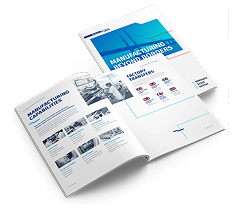As smart buildings become the norm rather than the exception, demand for integrated building automation and controls continues to climb. From energy savings and predictive maintenance to safety and real-time responsiveness, the building automation market represents a convergence of intelligent systems engineering and scalable manufacturing.
For OEMs in this space, understanding how the different subsectors—HVAC control systems, lighting automation, and security systems—compare in their manufacturing needs is critical when choosing the right EMS partner.
Here, we break it all down through the lens of BAC system integration and explore how a strategic EMS can support each subsector with precision and scalability.
HVAC control systems: Atmospheric necessity
HVAC control systems regulate heating, ventilation, and air conditioning within a building to ensure optimal environmental conditions and energy efficiency. From a manufacturing perspective, these climate-controlling, comfort-providing systems require high-tolerance components for thermal regulation, integration with complex sensors and actuators, and rigorous testing protocols for environmental endurance.
In a smart building context, HVAC systems must seamlessly integrate with BAC systems, which form the central nervous system of a building’s automation framework. They require deep integration into BAC protocols like BACnet or Modbus for real-time control and analytics.
For OEMs looking to outsource HVAC manufacturing solutions, priorities include:
- Compliance with energy standards (ASHRAE, ISO 50001)
- Modular design for multiple building types
- High MTBF (Mean Time Between Failures)
A well-suited EMS partner should offer vertically integrated manufacturing and strong design-for-compliance expertise, which can help HVAC OEMs reduce time to market while ensuring each unit passes through tight quality gates.
Lighting automation: Low power, high flexibility
Automated lighting systems offer occupancy sensing for optimal circadian rhythm syncing, daylight harvesting, and energy-saving scheduling; all essential for both occupant comfort and green building certifications.
Manufacturing lighting automation systems for the building automation market requires compact PCBAs that integrate into sleek, aesthetic designs, LED driver integration, and RF modules for wireless control (Zigbee, BLE, etc.).
From a building automation and control perspective, lighting systems are less complex than HVAC systems. Still, they must remain fully interoperable with BAC platforms and often need to be backwards-compatible with legacy infrastructure.
Outsourcing priorities for OEMs include:
- Cost-efficiency at scale
- Reliability over long usage cycles
- Interoperability with multiple building systems
The best EMS outsourcing partners leverage advanced automation and cost-optimised component sourcing to deliver both high-volume scalability and rapid prototyping options to support fast-changing lighting trends.
Security systems: Uncompromising reliability
Security is a non-negotiable in smart buildings, and access control, surveillance, and intrusion detection systems all need high, reliable uptime, real-time responsiveness, and bulletproof cybersecurity.
Manufacturing smart building security systems requires high-resolution imaging and sensor modules, secure firmware and encrypted data transmission, and multi-layer PCBAs with rigorous traceability. Security systems often serve as standalone systems, but they must “talk” to BAC systems for effective centralised monitoring and alerts.
For OEMs, outsourced security system solutions must have:
- Certifiable quality and audit trails (e.g., UL, CE, NDAA compliance)
- Tamper-proof hardware and firmware
- High reliability under mission-critical scenarios
From traceable manufacturing to dedicated engineering support, your EMS partner must ensure your security systems are built to the highest standards. To this end, it is worth checking that their NPI processes and cleanroom capabilities align perfectly with this vertical's stringent expectations.
BAC system comparative snapshot
|
Feature |
HVAC Control |
Lighting Automation |
Security Systems |
|
Design Complexity |
High |
Moderate |
High |
|
Certification Requirements |
Energy & Environmental |
EMC, Safety |
Security, NDAA, CE |
|
Supply Chain Sensitivity |
Medium: Requires reliable components but typically uses well-established, long-life parts with moderate sourcing complexity |
High: Rely heavily on pricing-volatile components like LEDs and drivers, making sourcing a margin-critical function. |
Very High: Demand trusted, compliant sources due to data integrity, cybersecurity concerns, and export control regulations. |
|
BAC Integration |
Deep Integration: Requires real-time, bidirectional communication for temperature and air quality control. |
Moderate Integration: Often connect to BAC platforms for energy optimisation and scheduling, but can operate semi-independently. |
Peripheral Integration: Usually run on dedicated networks with minimal BAC interaction, primarily for event logging or alarm escalation. |
|
ESCATEC’s Unique Advantage |
Design-for-compliance |
Cost-optimised volume |
Traceable, secure builds |
Conclusion
Beyond “connected systems”, building automation is about reliability, precision, and staying ahead of evolving standards. Whether it’s the next innovation in HVAC, natural-light automation, or futuristic security that seems straight out of a science-fiction movie, every subsector in the building automation market can benefit from bespoke solutions that match the market’s demand for transformation, compliance, and time-to-market excellence.
At ESCATEC, we offer OEMs leading the way in the BAC space supply chain flexibility and scalability, peer-to-peer technical collaboration, sophisticated testing, and a proactive improvement approach that provides the peace of mind needed in high-stakes applications.
Download our guide on utilising EMS providers to outsource your smart building and automation control equipment, or contact us to discover how our precision manufacturing services can enhance your next product launch.


